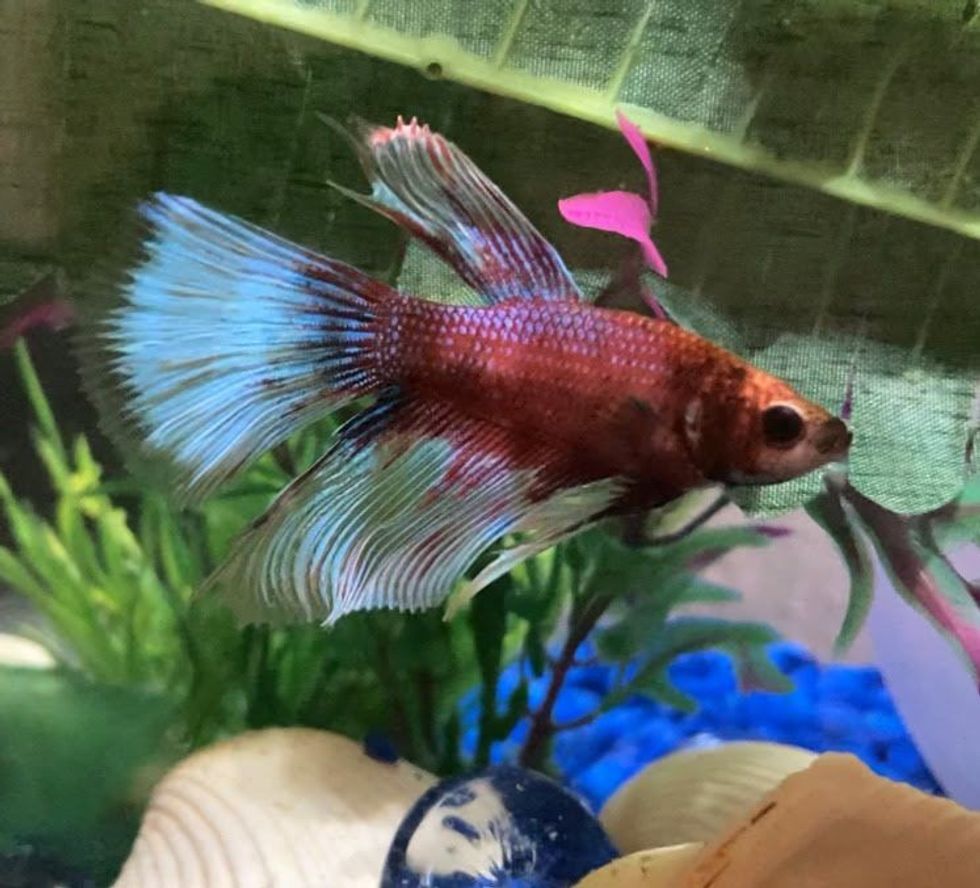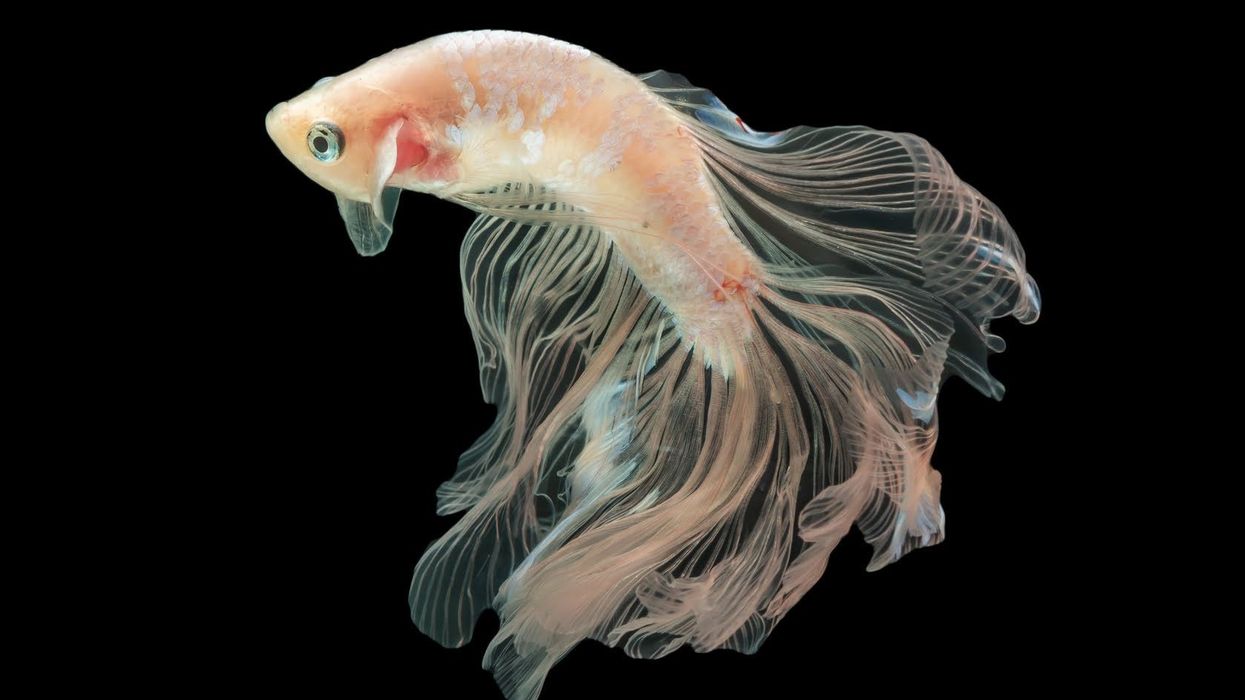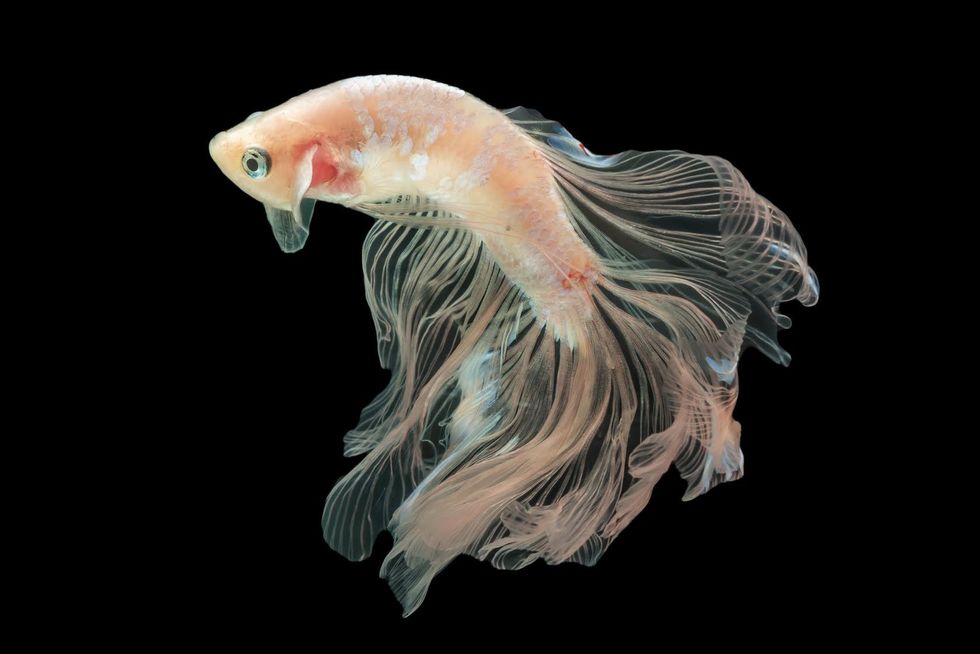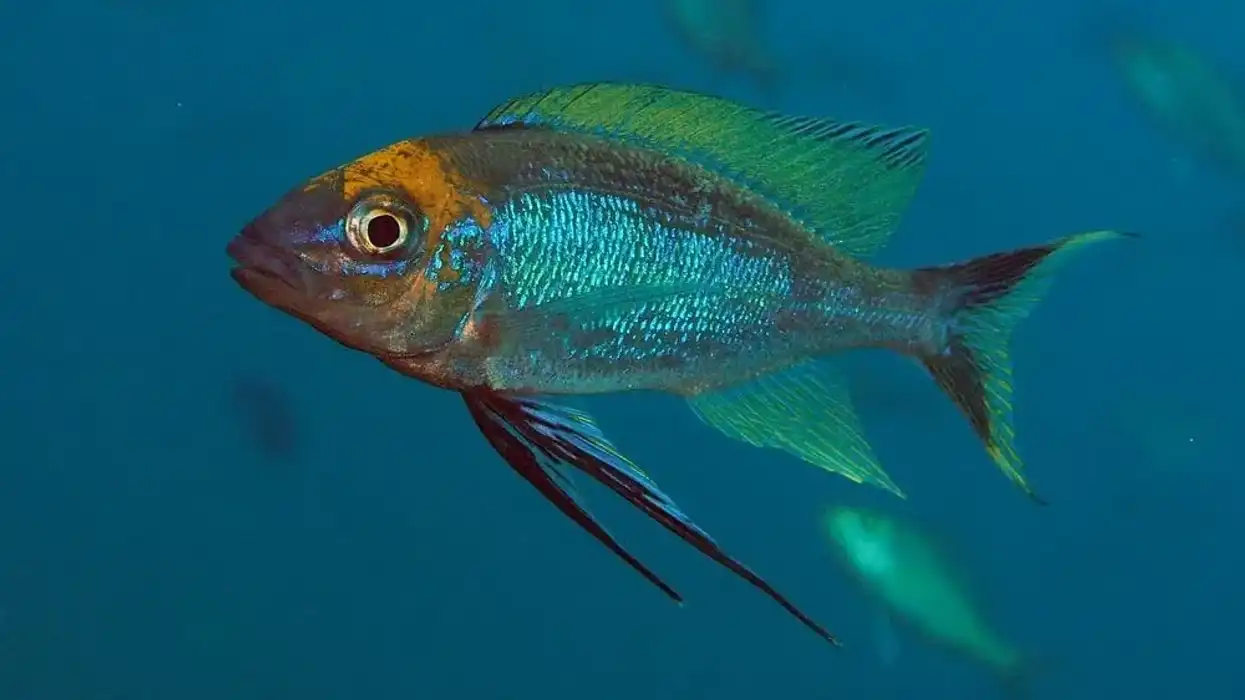Fun Cellophane Betta Facts For Kids

The betta fish is an utterly breathtaking freshwater fish that is loved by many all over the world. Bettas come in a wide variety of colors with different types of tails and scale patterns.
The beautiful cellophane betta fish is a clear Siamese fighting fish (Betta splendens) that has no color over the majority of its body.
These betta fish have translucent or whitish scales through which one can even see the pink shade of their small muscles as well as their internal organs!
Their stunning fins are most of the time clear but are sometimes opaque. Its betta fish body lacks intense coloration and appears to be colorless as it does not possess one out of the three pigments in its chromatophores.
Male betta fish are highly desired in the aquarium trade because of their fabulous flowing tail and intricate patterns. Females are also quite beautiful, however, they lack the aggression and flowing tail that male bettas possess.
Wild bettas are indigenous to the Mekong Delta of Southeast Asia and these betta fish prey upon insect larvae and eggs.
Breeders have selectively bred lines with distinct qualities from 70 species of wild bettas, thus, there is an extensive variety of betta fish across the world.
The cellophane betta is a unique Siamese fighting fish that is mostly white and pink, along with an iridescence that is green, royal blue, or steel blue in color. To know more about the cellophane betta fish, we suggest you continue reading!
If you enjoyed reading about our cellophane betta facts, you'll certainly love to read about the mutton snapper and the clown triggerfish.
Cellophane Betta Interesting Facts
What type of animal is a cellophane betta?
The cellophane betta is a stunning fish that is almost colorless and possesses just a hint of iridescence that is green, royal blue, or steel blue. It's a member of the glamorous family of bettas: Osphronemidae.
The Osphronemidae family has plenty of fabulous fish species as its members like the dragon scale betta, orange betta, copper betta, dalmatian half-moon betta, yellow betta, and many more that have gorgeous metallic and non-metallic coloration!
What class of animal does a cellophane betta belong to?
Cellophane bettas belong to the class Actinopterygii.
How many cellophane bettas are there in the world?
The population of magnificent cellophane bettas is unknown.
These Siamese fighting fish are decreasing in number in the wild, but increasing in number in captivity as their breeding is taking place on farms that are producing large numbers of cellophane bettas, and other kinds of bettas like black orchid bettas, copper bettas, orange bettas, yellow bettas, dragon scale bettas and many more.
Where does a cellophane betta live?
The cellophane's (Betta splendens) native location region is in the Mekong Delta of Southeast Asia, namely the east and central areas of Thailand, the Malay Peninsula, the south region of Vietnam, and Cambodia. Betta splendens are known to inhabit shallow water bodies that have extensive plants, like paddy fields, marshes, and floodplains.
These betta fish usually found at depths ranging between 0.7-11.8 in (1.7-29.9 cm). These fish have established their populations in Brazil, Colombia, the southeast USA, the Dominican Republic, and Singapore as well.
What is a cellophane betta's habitat?
Female cellophane betta fish are known to eat their eggs as well as their fry, so a male might kill it to prevent that from happening. Thus, dense vegetation allows females to hide during the breeding season, so that the male does not get aggressive.
It also helps fry (baby fish) in hiding as they're quite vulnerable. These gorgeous betta fish can exist in harsh conditions, which reduces the number of predators as not many fish can exist in such conditions.
A cellophane betta's habitat comprises great variations in temperature and water availability. Their pH ranges between 6.9-8.2. The temperature also has great fluctuations and ranges between 59-100 F (15-37.7 C).
This proves how extremely adaptable these Siamese fighting fish are. Their adaptability attracts many potential pet owners.
Who do cellophane bettas live with?
Cellophane bettas are highly territorial and like to mark their territories. As their name suggests, these Siamese fighting fish can be quite aggressive. In an aquarium, this betta fish must be kept with peaceful shoaling fish, like danios and tetras.
How long does a cellophane betta live?
The cellophane betta can live in the range of two to four years, similar to that of the rainbow trout. Its life expectancy entirely depends upon its environment and diet.
How do they reproduce?
When betta fish breed, males take the task to construct a bubble nest (a nest made of bubbles that contain saliva) to lure females. When the female agrees, male and female bettas then engage in mating rituals.
The male betta fish embraces the female betta fish, by completely wrapping his body against hers, called a nuptial embrace, while she lays 10-40 eggs, which the male betta fish rushes to catch before they sink or are eaten by the female betta fish.
The male betta fish externally fertilizes the eggs he manages to catch and cares for them. Interestingly, the female is kept away as otherwise she will eat the eggs, or get in a fight with the male betta fish, who will end up killing her.
The incubation process of the eggs takes approximately 24-36 hours.
The larvae reside in the nest for two to three days until the yolk-sacs have been completely absorbed. The cellophane betta fish is bred by humans in farms as well as in the wild.
What is their conservation status?
These fish have a Vulnerable conservation status as per the IUCN's Red List as betta numbers in the wild have declined. However, in captivity, these betta fish are being bred in large numbers.
Cellophane Betta Fun Facts
What do cellophane bettas look like?
Most bettas have a metallic-colored body, different scale types, and possess a distinct pattern on their scales and tails. However, the cellophane betta is bi-color and possesses translucent or whiteish scales through which the pink color of their muscles can be seen.
They do not possess vibrant coloration.
Sometimes their internal organs are also visible.
Their magnificent fins are opaque or clear. They show a hint of iridescence in the right light that is green, royal blue, or steel blue in color and their eye color is completely black.
Like cellophane bettas, butterfly bettas (possessing a dominant gene) also have fins that are cellophane-like, with the color separating from the edge of all of their fins, namely dorsal, caudal, and anal fins, with the tail possessing only 50% of color. Cellophane bettas appear colorless as they do not have one of the three pigments present in their chromatophores.
As this trait is not expressed in these bettas, they don't possess many colors, unlike other species of their family that possess vividly colored bodies that come in an extensive range of colors like yellow, dark red, orange, bright red, purple, and many more.

How cute are they?
These fish are very cute. They do not have any vivid colors on their bodies but still manage to look quite lovely and have a serene appearance with magnificent clear fins.
How do they communicate?
Male bettas spread out their fins, twist and turn their body as a dance, as well as flare out their gills, to communicate with a female. Betta fish also communicate by glass surfing in an aquarium, by pacing up and down to signal that something isn't right.
How big is a cellophane betta?
The cellophane betta fish ranges between 2.-3 in (6-8 cm) in length. The cellophane betta fish is almost the same size as the black molly.
How fast can a cellophane betta swim?
The speed of cellophane betta fish has not been evaluated yet. However, they're quite intelligent and smart swimmers. They can learn a few tricks like jumping from a hoop, how to follow a finger and how to jump in and out of the water.
How much does a cellophane betta weigh?
Cellophane betta fish weigh between the range of 0.09-0.10 oz (2.5-2.8 g).
What are their male and female names of the species?
Males are referred to as male cellophane betta fish, whereas, females are referred to as female cellophane betta fish.
What would you call a baby cellophane betta?
A baby cellophane betta fish is known as fry.
What do they eat?
The cellophane betta fish is a carnivorous fish that naturally preys upon tiny crustaceans, larvae of aquatic insects, and zooplankton. In captivity, they can be fed a chopped pea once in seven days to relieve constipation. They're preyed upon by larger fish, salamanders, cats, and birds.
Are they dangerous?
No, the stunning cellophane betta fish aren't dangerous at all.
Would they make a good pet?
Yes, cellophane betta fish will be great pets. However, as these creatures are very delicate, it is quite challenging to cater to their needs.
Did you know...
Mustard gas bettas are common and often appear with a bi-color bluish or green body. Their color changes to orangish or yellowish fins and their fins' edges can be dark-colored, such as black.
True halfmoon bettas possess a tail that is 180 degrees round (D-shaped). These halfmoon bettas' coloration can be a blend of many colors or of just a single color. Their pectoral fins are known as 'dumbos'.
Elephant ear bettas have wide and elongated ears which make it look like these bettas have huge ears on their heads. These betta fish are prone to swim bladder disease.
Crowntail betta fish have spike comb-like tails that look like an upside-down tiara.
The dragon scale betta has thick scales that are opaque. Dragon scales have a characteristic 'skunk' stripe which is a red-colored stripe that is as long as their bodies and is situated at the top of all dragon scales.
The hellboy betta is a very famous, high-quality betta of fin variety that has a plakat body. They possess a blend of vibrant colors on their scales with five colors or even more! The red color is the most dominant color in these bettas.
What is the rarest betta color?
The rarest color of all the broad variety of colors that bettas exist in, is purple. The purple-colored betta fish is the rarest and the most expensive of all betta fish.
True purple bettas are very rare. There might be other bettas that have purple colors and a dominant shade of red or blue, that are relatively cheaper. The fantail variety of betta fish is the rarest type of bettas.
Why are betta fish kept in small containers?
Betta fish are kept in containers as they're highly territorial, and as their name suggests, they will get aggressive and end up fighting with each other, which will perhaps cause the death of one. Betta fish have to be kept separately until they mature.
Here at Kidadl, we have carefully created lots of interesting family-friendly animal facts for everyone to discover! Learn more about some other fish from our rockfish facts and Spanish mackerel facts pages.
You can even occupy yourself at home by coloring in one of our free printable cellophane betta coloring pages.
Thank you to Kidadler Phantom Miria for providing the image of their Cellophane Betta in this article.
We Want Your Photos!
More for You
See All
Bachelor of Business Administration specializing in Management

Rhea NischalBachelor of Business Administration specializing in Management
A background in Business Administration and Management from MCM DAV College, Rhea has led her to work for her father's global business. However, her passion for content production, where she manages operations to ensure all processes run smoothly. Outside of work, she enjoys playing the piano and spending time with her one-year-old nephew.
Bachelor of Commerce specializing in Marketing and HR

Pradhanya RaoBachelor of Commerce specializing in Marketing and HR
With a Bachelor’s degree in Commerce from Christ University, Bangalore, Pradhanya's passion for the English language and literature led her to explore the field of content writing, where she has gained extensive experience in writing, reviewing, editing, and fact-checking. She has also earned certifications in Google Ads Search, Google Ads Display, and Social Media Marketing, showcasing her proficiency in digital marketing.
Disclaimer
1) Kidadl is independent and to make our service free to you the reader we are supported by advertising. We hope you love our recommendations for products and services! What we suggest is selected independently by the Kidadl team. If you purchase using the Buy Now button we may earn a small commission. This does not influence our choices. Prices are correct and items are available at the time the article was published but we cannot guarantee that on the time of reading. Please note that Kidadl is a participant in the Amazon Services LLC Associates Program, an affiliate advertising program designed to provide a means for sites to earn advertising fees by advertising and linking to Amazon. We also link to other websites, but are not responsible for their content.
2) At Kidadl, we strive to recommend the very best activities and events. We will always aim to give you accurate information at the date of publication - however, information does change, so it’s important you do your own research, double-check and make the decision that is right for your family. We recognise that not all activities and ideas are appropriate for all children and families or in all circumstances. Our recommended activities are based on age but these are a guide. We recommend that these ideas are used as inspiration, that ideas are undertaken with appropriate adult supervision, and that each adult uses their own discretion and knowledge of their children to consider the safety and suitability. Kidadl cannot accept liability for the execution of these ideas, and parental supervision is advised at all times, as safety is paramount. Anyone using the information provided by Kidadl does so at their own risk and we can not accept liability if things go wrong.
3) Because we are an educational resource, we have quotes and facts about a range of historical and modern figures. We do not endorse the actions of or rhetoric of all the people included in these collections, but we think they are important for growing minds to learn about under the guidance of parents or guardians.







